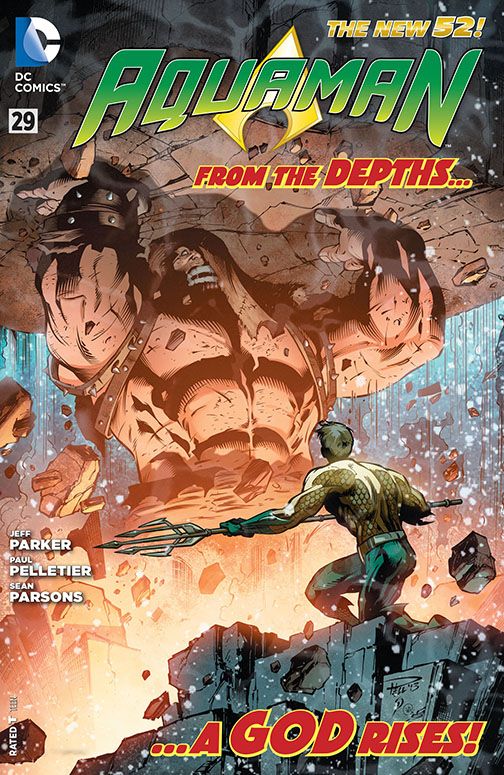The current era of comics is likely the peak of Aquaman's popularity and visibility in the DC Universe, especially with the Sea King anchoring a second title in the very near future. With that in mind, Jeff Parker and Paul Pelletier use "Aquaman" #29 to seed stories for issues to come, introduce more foes for Arthur and cement his place in the DC Universe with teases of team-ups and crossovers to come.
The cover has changed a bit since the original solicitation that resembled a pre-New 52 Atlas, but "Aquaman" #29 introduces a New 52 version of Hercules. The Olympian has an axe to grind with Atlantis and Hercules' apparent allies do as well, exerting a disturbing level of influence over the demigod. Naturally, Aquaman represents all things Atlantis, so chaos boils over. As for how the Olympian and crew came to invade the mortal realm, all manner of hell is unleashed through a portal opened via Aquaman's trident. The main action takes place in the Azores, far from throngs of people and overwhelming construction. That opens up the pages for Paul Pelletier to go crazy, flexing his muscles and drawing all sorts of mythology-tinged behemoths and beasties. Sean Parsons' inks over Pelletier's pencils meld together nicely, with new colorist Rain Beredo able to shade the events in a most energetic manner. There is a lot more red and orange in the settings and backgrounds than in a standard-issue Aquaman comic, but when a portal to hell is flung open, I suppose that it to be expected.
Pelletier does an excellent job adding variety to the attacking horde, from changing up the design on Hercules to something less-prescribed to designs for Celeana, an über-creepy harpy who leads the charge of the giant-born from their exile. These monstrosities have no care for the world they invade, attacking everyone and causing chaos and destruction. Some of their victims are fatally attacked, but Pelletier, Parsons and Beredo manage to keep the book mostly free of gore without compromising the horror of the attack. The visuals are rounded out with shifty lettering for the giant-born from Dezi Sienty that has a disturbing shadow to it, delivering an echoey effect for the eyes.
In addition to fighting the giant-born, Aquaman is summoned to Atlantis following the outbreak of algae that threatens to disrupt the ecosystem. Parker uses this to serve as foreshadowing for the crossover between "Aquaman" and "Swamp Thing," and even teases the reader all the more with a one-panel appearance of the muck monster formerly known as Alec Holland. Parker doesn't just focus on one line, plot or subplot, building out the world around Aquaman in every direction at the same time. He does so in a masterfully organic matter, adding incredible potential to continue forward and even to refresh Atlantean legend.
"Aquaman" #29 is a magnificent example of what Parker and Pelletier bring to this series. The titular character is every bit human as he is hero and, like the rest of us, finds himself in situations that he may not always be properly prepared for. His heart is in the right place and his head is clear enough to do the right thing, but victory never quite seems like a guarantee. "Aquaman" does a great job of standing apart, while remaining plugged in to the rest of the DC Universe, continuing to add to larger picture around the maritime legend. In "Aquaman" #29, Parker and Pelletier show readers they need no long-standing history with the Sea King in order to enjoy a riveting tale that happens to be filled with world-building.

